UFZ background 15th March 2005
Particulates – a serious threat to health
Ever tinier particles are coming under the researchers’ microscopes
Our senses are not attuned to this danger. You can’t smell them, you can’t taste them and particulates are not visible to the naked eye. They are tiny, with a diameter not even a tenth of that of a hair. Yet they have a major impact. The particles penetrate into the body through the lungs and can cause respiratory diseases and also diseases of the cardiovascular system.
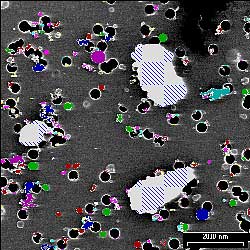
particulates under the researchers’ microscopes
Source: UFZ
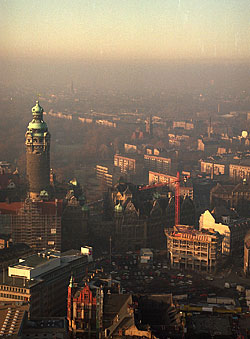
smog in urban regions, e.g. Leipzig, Germany
Source: Norma Neuheiser/UFZ
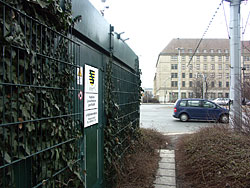
monitoring station in the city centre of Leipzig
Source: Norma Neuheiser/UFZ
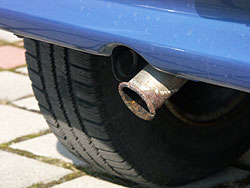
traffic as a main source of particulates
Source: Norma Neuheiser/UFZ
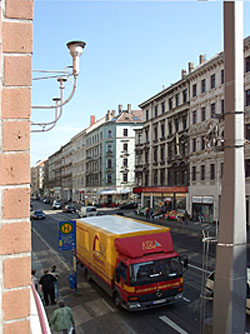
monitoring station of the UFZ and the Leibniz Institute for Tropospheric Research (Eisenbahnstreet in Leipzig, Germany)
Source: Norma Neuheiser/UFZ
The particles penetrate into the body through the lungs and can cause respiratory diseases and also diseases of the cardiovascular system. The World Health Organization (WHO) estimates that even 10 micrograms of particulate matter per cubic metre of air are sufficient to cause a reduction in life expectancy of six months. "Particulates are now among the greatest threats to health in urban areas", states Dr Martin Lanzendorf of the UFZ Centre for Environmental Research (Umweltforschungszentrum Leipzig-Halle) of the importance of the research. According to a recent study by the European Commission, 65,000 deaths per year in Germany are due to cardiovascular diseases which are caused or at least intensified by air pollution.
New limit values
Since 1 January 2005 the new EU Directive on particulate matter, which lays down stricter limit values, has been in force. Particulate values must not exceed the limit of 50 micrograms per cubic metre of air on more than 35 days per year. Cities and agglomerations are the areas most affected by PM10, as scientists call it. PM stands for particulate matter and 10 denotes the particle size of 10 micrometres, that is one hundred thousandth of a metre. Munich tops the table of current statistics, where the limit has been exceeded 27 times since the beginning of the year. In the new federal states of eastern Germany the limit has been exceeded most often at the Leipzig Central measuring station. So far the upper PM10 limit has been exceeded on 15 days there.
Diesel soot filters a first step
The German Federal Environment Agency (Umweltbundesamt) has identified traffic as the chief source of particulate matter. In particular, the increase in the numbers of diesel vehicles has exacerbated the situation in Germany. For this reason experts from the Federal Environment Agency are calling for the introduction of diesel soot filters. These filters stop up to 99.99 per cent of the particulate matter from getting into the atmosphere and that could be a big step forward. This is the opinion of the experts who met in Leipzig in February for a workshop organised by the UFZ Centre for Environmental Research and the Leibniz Institute for Tropospheric Research (Leibniz-Institut für Troposphärenforschung – IfT).
Local authorities face difficult decisions
However, it will be years before the majority of vehicles are fitted with such filters. Meanwhile the towns and cities affected must undertake measures this year to protect the population. "If the trends seen in the first few weeks of the year continue, several German cities will have to take drastic action in the summer at the latest, in order to keep within the limit values", said Dr Martin Lanzendorf, who conducts research with the Sustainable Mobility working group at the UFZ. "This might involve road closures, speed limits or bans on driving diesel vehicles." Environmental organisations are already threatening test cases in the event that the limit values are exceeded more often than permitted. In 2003 this applied to one in three of the measuring stations in Germany’s nationwide network, although the EU Air Quality Framework Directive was not yet in force at that time.
Ever finer particles under the scientists’ microscopes
The debate so far has been about PM10, particles with a diameter of less than 10 micrometres. However, scientists fear that the most dangerous particles are even smaller than this. Currently there are neither limit values nor a monitoring network for such particles. These ultrafine particles are smaller than 100 nanometres, that is less than one ten millionth of a metre. Experts are unanimous in believing that smaller particulates can penetrate significantly more easily and further into the human body. "The body has a number of defence mechanisms against larger particles", explains Dr Ulrich Franck of the UFZ. "However, humans have no such defence mechanisms against smaller particulates." Scientists from the GSF National Research Centre for Environment and Health (GSF-Forschungszentrum für Umwelt und Gesundheit) in Munich have now been able to prove that these ultrafine particles are carried into the blood circulation system, the heart, the liver and other organs and can even reach the brain. "What impacts they have there is largely unknown. Nevertheless, initial research points, for example, to disrupted protein reactions, that is oxidative stress", warns Dr Wolfgang G. Kreyling of the GSF Research Centre. "Also, the immune system appears to be affected in more ways than was previously thought."
Are measuring techniques still adequate?
The current measuring techniques focus on the overall mass of the particulates. However, in the case of ultrafine particles the issue is more about the number of particles than the mass. Moreover, lots of smaller particles have a larger overall surface area, even though they weigh less. "We need to rethink", says Franck, going on to mention many as yet unsolved problems. Evidence already exists to suggest that internal concentrations behave very differently from external concentrations. For three years the UFZ and the Leibniz Institute for Tropospheric Research have been jointly monitoring Eisenbahnstraße in Leipzig. They have recorded the longest continuous series of measurements in a street canyon in Germany and this proves the positive impact on air quality of traffic-calming measures and speed restrictions. Parallel to this, pollution concentrations are monitored in cooperation with the Düsseldorf Environmental Health Research Institute (Institut für Umweltmedizinische Forschung) at 30 other measuring points in Leipzig, in order to examine the links between particulates and allergies in children.
Further research needed
It is clear that the number of cars will continue to rise over the next few years and that traffic is the main cause of ultrafine particles in cities. But
how can the dispersal of the particulates be predicted so that effective protection for the population can be provided? Do we perhaps also need limit values
for ultrafine particles? The new EU air quality Directive is only one stage in the process. Scientists and politicians will have to continue to deal with the
particulate problem in the future.
Tilo Arnhold
Further information is available from:
Dr. Martin Lanzendorf
UFZ - Department Urban Ecology, Environmental Planning & Transport
www.ufz.de/index.php?de=2589
phone: +49 341 235 -2733
e-mail: martin.lanzendorf@ufz.de
Dr. Ulrich Franck
UFZ - Department of Human Exposure Research and Epidemiology
phone: +49 341 235 -2929
e-mail: ulrich.franck@ufz.de
Dr. Wolfram Birmili
Leibniz-Institut für Troposphärenforschung
www.tropos.de/INFO/personal/birmili.html
phone: +49 341 235 -3437 or -2467
or
Doris Böhme / Tilo Arnhold,
Public Relations of Helmholtz Centre for Environmental Research – UFZ
Phone: +49-341-235-2278
e-mail: presse@ufz.de
